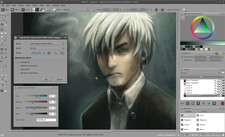Krita: Listening to the pros
Illustrative

© CC BY-SA
Krita began as a hobby but became one of free software's success stories with the help of its users.
In 15 years, the Krita [1] digital painting and illustration application has gone from a rudimentary paint program to the breakout success in Calligra Suite that artists are starting to prefer over PhotoShop or GIMP.
Recently, Boudewijn Rempt, Krita's maintainer during much of its progress, took time from his holiday to talk about Krita's history, where the project is today, and its future direction. Rempt became interested in free software just out of university, writing a mail and news client and a database application for linguistics. After he wrote a book on PyQt, he looked around for another project to become involved in.
"Coincidentally, I got a cheap Wacom Graphire tablet," Rempt recalls. "I didn't really grok GIMP back then, so I did what comes natural: I started a new project, a new painting application. That lasted about half an hour before I realized I hadn't got a clue how to do a painting application!" Instead, he started looking for existing projects to join.
[...]
Buy this article as PDF
(incl. VAT)
